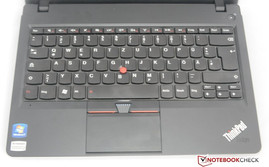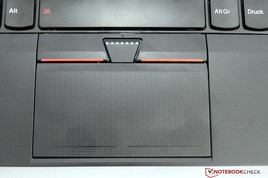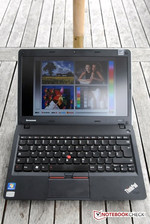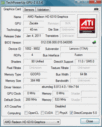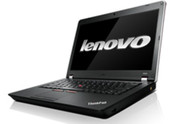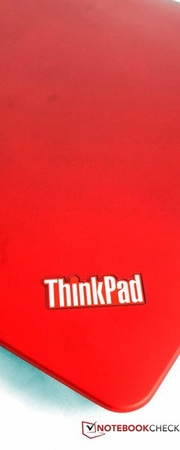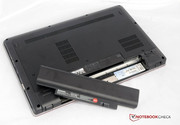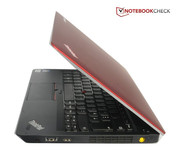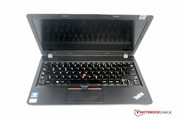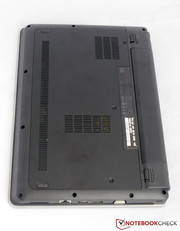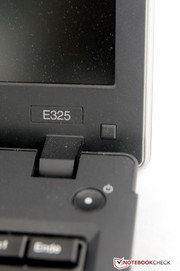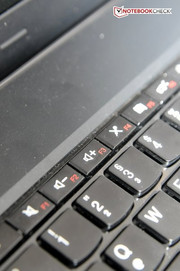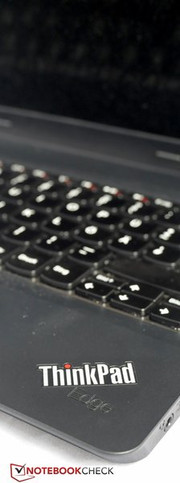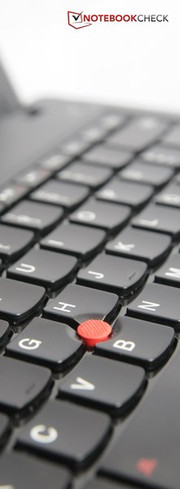Review Lenovo ThinkPad Edge E325-12972FG Notebook
"Though through, slim and light", that's how Lenovo is advertising its new 13.3 inch sized ThinkPad Edge models E320 and E325. A review of the more powerful model E320 (Core i3-2310M) was already published on Notebookcheck several days ago. In contrast to the Lenovo ThinkPad Edge 320, the E325 (1976FG) model reviewed by us has AMD Fusion. Inside the subnotebook an AMD dual-core processor E-350 (2x 1.60 GHz) with an integrated AMD Radeon HD 6310 graphics unit has been included. For an affordable 420 Euros this comes with a non-reflective 13.3 inch display (1366 x 768), as well as 2 GBytes of DDR3 RAM (1333 MHz). The hard drive is a slow 320 GByte Hitachi model with 5400 rpm rotational speed. An optical drive is not included. Neither is there an up-to-date USB 3.0 port available. The operating system is a pre-installed Windows 7 Premium Edition (64-bit) from Microsoft.
So far models from the Edge series, amongst other things due to the good stability, have been able to make a good impression on us. How the AMD powered subnotebook is able to fair can be discovered in the following review.
Case
Our reviewed model is fitted with a red display lid. The case is almost identical to that of the previously reviewed models E320, X121e, and E125. Unfortunately the Edge subnotebook has become worse in terms of robustness, compared to older ThinkPad models. The chassis can easily be bent. The palm resting area in comparison only dents very little with a lot of pressure. Nevertheless the keyboard can be dented more easily in some places though.
The display itself can be bent easily. Also the display hinges are no longer quite as stable and allow the display to wobble. The base plate in contrast is robust. Only three screws separate the user from access to the insides of the device. Lenovo's ThinkPad Edge E325 definitely doesn't belong among the heaviest subnotebooks with a weight of 1.7 kilos.
Connectivity
The ports on the Lenovo ThinkPad E325 are unfortunately located on the left and right sides of the subnotebook. Interfaces at the rear and front are not provided. Due to this the connection of several devices can lead to a lot of cables. Using an external mouse is difficult, since there is little space and the cable can easily become intertwined with the other cables. There is also not a large range of interfaces. There are altogether three USB version 2.0 ports available, among which one is an eSATA combination port. Otherwise there is also a separate microphone port missing.
Communication
Compared to its brother the E320, the reviewed device is missing an HSDPA module. The WLAN module supports the protocols 802.11b, 802.11g, as well as 802.11n. A Gigabit Ethernet controller from Atheros and Bluetooth are provided by Lenovo. The latter even supports the up-to-date version 3.0.
Security
Since the subnotebook is intended for business users, the security plays an important role. For this, as usual, there is a Kensington Security Lock available. The keyboard itself is marginally waterproof. Nevertheless a finger print reader is missing, something that is not too much of a disappointment in this price range though.
Accessories
Accessories included with the delivery are very limited. Merely a user manual is in the package along with the subnotebook itself.
Warranty
The standard warranty for Lenovo's ThinkPad Edge E325 lasts for 12 months. The ThinkPlus warranty extension increases this by a further 24 months. Depending on the type of warranty, this costs about 55 Euros (Bring-In) or 85 Euros (on location).
Input Devices
Keyboard
The keys of the ThinkPad have a concave surface, which helps the fingers lie better in the keys. The key travel is pleasant, as well as the pressure point. The F buttons are however only activated by the Fn key. The highest priority is for special functions such as 'Play' and 'Stop'. This can be especially hard to get used to for users used to other conventions.
The keys, as already mentioned, can be more easily pressed in towards the outsides. Further to this the keys are not rubbery, which makes them more slippery. Altogether typing with the subnotebook is nevertheless still fun.
Touchpad/Trackpoint
The mouse replacement provided by Lenovo ThinkPad Edge E325 can be either the touchpad or the Trackpoint. The red Trackpoint sits between the G, H, and B keys. The buttons for this are located directly beneath the space bar. These are sufficiently sized, and provide decent feedback.
The touchpad has a structured surface. Lenovo has opted not to include the usual separate buttons under the touchpad. Instead the surface of the touchpad can be pressed at the edges, which is supposed to replace the buttons. Due to this the whole touchpad becomes wobbly though, and pressing the buttons requires a certain amount of pressure.
Display
The ThinkPad E325 has a 13.3 inch matte display (LEN4090). The native resolution is, as usual for displays of this type, 1366 x 768 pixels. The display with a 16:9 aspect ratio has a relatively weak contrast. This is a mere 162:1. The black level of 1,09 cd/m² is noticeably high.
| |||||||||||||||||||||||||
Brightness Distribution: 90 %
Center on Battery: 177 cd/m²
Contrast: 162:1 (Black: 1.09 cd/m²)
43.68% AdobeRGB 1998 (Argyll 3D)
61.8% sRGB (Argyll 3D)
42.05% Display P3 (Argyll 3D)
The results for the measurement of brightness with the Gossen Mavo-Monitor are disappointing. On average the measured brightness was merely 174.6 cd/m². In some places the maximum value of 182 cd/m² was measured in the upper right corner. Whether the subnotebook is connected to the power supply or is powered by the battery makes no difference in this case. We suspect that the use of the ThinkPad Edge E325 outdoors won't be a lot of fun, despite the matte display. At least the distribution of brightness is well balanced at 90 percent.
As usual we also tested the viewing angle stability in a dark room. When moving the display horizontally, the displayed image changes within the limits of tolerance. When deviating vertically the image quickly inverts. Considering the altogether weak display, the result is not exactly surprising.
Performance
Lenovo is relying on the AMD Fusion E-350 APU for the ThinkPad Edge E325. This processor is equipped with two cores, and operates with a clock speed of 1.6 GHz. The TDP from the AMD Fusion E-350 APU with 1024KB of L2 cache is a mere 18 Watts. The chipset included is the AMD A50M FCH.
APU is an abbreviation for Accelerated Processing Unit. This means that the processor and graphics unit are combined. In the case of the AMD Fusion E-350 APU, this is the AMD Radeon HD 6310 with 80 shaders. The graphics unit supports DirectX 11 and the UVD3 video decoder for HD videos (MPEG-2, H.264, VC-1) as standard.
The RAM included as standard is 2 GBytes of DDR3 RAM (PC3-10600). The hard drive is made by Hitachi, and provides 320 GBytes of capacity, with a rotational speed of 5400 rpm.
The AMD Fusion processors don't belong among the most powerful, but are more likely to be able to make a good impression due to the integrated graphics unit. The CPU performance was tested by us using the Cinebench benchmark from Maxon. In this case the Lenovo ThinkPad Edge E325 score, as could be expected, is in the lower area of our benchmark database. With 2195 points the subnotebook results for the Cinebench R10 multi (64-bt) benchmark are between those of other notebooks with the same processor. The best counterpart with the E-350 processor is the Wind U270 from MSI, which scores 2250 points. A similar picture emerges when it comes to the Cinebench R11.5. In this case the reviewed device also lags behind with 0.6 points in the CPU test. This time other notebooks with the AMD processor also score 0.6 points.
For comparison: Lenovo's Edge E320 with the Intel i3-2310M CPU manages to score 7398 points in the same test, which is more than twice as much as the AMD chip in the reviewed model.
| Cinebench R10 - Rendering Multiple CPUs 64Bit (sort by value) | |
| Lenovo ThinkPad Edge E325-12972FG | |
| Lenovo ThinkPad Edge E320 NWY3RGE | |
We analysed the system performance using PCMark Vantage and PCMark 7 from Futuremark. Using PCMark Vantage Lenovo's subnotebook managed to score 2278 points, and thus belongs among the best devices with the same processor. Only the model ThinkPad x120e, also by Lenovo, is better and manages to score 2600 points. Using PCMark 7 the Lenovo ThinkPad Edge E325 only manages to score 933 points. In this case the other model that is better is also the ThinkPad x120e, which scored 1101 points. The bigger brother E320 in comparison manages to score more than twice the amount with 2009 points.
| PCMark Vantage Result | 2278 points | |
| PCMark 7 Score | 933 points | |
Help | ||
The integrated AMD Radeon HD 6310 graphics unit had to put up with several 3DMark benchmarks from Furmark. Using this the Lenovo ThinkPad Edge E325 managed to score a whole 2048 points in 3DMark2006. With this result the reviewed device is the best model with the AMD Radeon HD 6310, and positions itself in the middle range of our benchmark database. Those that think that this is the discipline in which the Intel variant is beaten are wrong. The counterpart with the i3-2310M CPU and an integrated HD 3000 graphics unit, is also able to distance itself in this case with a total of 3098 points.
A similar picture emerges with the 3DMark 11 benchmark. In this case the reviewed device is once again the best model in its class with 286 points. Below this are only notebooks with the Radeon HD 6250.
| 3DMark 03 Standard | 5782 points | |
| 3DMark 05 Standard | 3765 points | |
| 3DMark 06 Standard Score | 2048 points | |
| 3DMark Vantage P Result | 718 points | |
| 3DMark 11 Performance | 286 points | |
Help | ||
We tested the hard drive performance of the Lenovo ThinkPad Edge E325 with HD-Tune. The hard drive in the subnotebook is made by Hitachi. This has a storage capacity of 320 GBytes, and a rotational speed of 5400 revolutions per minute. Thus the average transfer rate lies at a meager 55.5 MB/s. An SSD is not included in this price range, although a hard drive with 7200 rpm would have been preferable.
Emissions
System Noise
As long as users of the ThinkPad Edge E325 only utilize it within limits, such as when surfing the internet or while using word processing programs, then the cooling fan doesn't even start turning. Thus the system noise measures 30.1 dB(A). The included hard drive from Hitachi is audible with about 30.7 dB(A) when in use. These are altogether very good values.
When demanding a lot from the subnotebook, the system generates a higher operating temperature, which has to be reduced by the cooling fan. Under load we measured values of between 36.5 dB(A) and 36.7 dB(A). This may be clearly audible, but doesn't represent disturbing noise levels.
Noise level
| Idle |
| 30.1 / 30.1 / 30.2 dB(A) |
| HDD |
| 30.7 dB(A) |
| Load |
| 36.5 / 36.7 dB(A) |
 | ||
30 dB silent 40 dB(A) audible 50 dB(A) loud |
||
min: | ||
Temperature
The temperature developed by the ThinkPad Edge E325 is definitely reasonable. During office use the upper surface temperature increases to a maximum of 29.1 C, the bottom get's a little warmer with a maximum of 32.8 C. Following more than an hour of Furmark combined with Prime95 during the stress test, the temperature of most notebooks increases significantly. This is not the case with the reviewed model. In this case the temperature difference compared to that generated during office use almost isn't noticeable. The surface around the keyboard reaches a maximum of 31.1 C, while the bottom temperature is exactly two degrees higher. In this case the system from Lenovo is able to score top marks.
(+) The maximum temperature on the upper side is 31.1 °C / 88 F, compared to the average of 35.9 °C / 97 F, ranging from 21.4 to 59 °C for the class Subnotebook.
(+) The bottom heats up to a maximum of 33.1 °C / 92 F, compared to the average of 39.3 °C / 103 F
(+) In idle usage, the average temperature for the upper side is 28.6 °C / 83 F, compared to the device average of 30.8 °C / 87 F.
(+) The palmrests and touchpad are cooler than skin temperature with a maximum of 29.7 °C / 85.5 F and are therefore cool to the touch.
(±) The average temperature of the palmrest area of similar devices was 28.2 °C / 82.8 F (-1.5 °C / -2.7 F).
Speakers
Its definitely not possible to find the speakers on this edition of the ThinkPads without taking a closer look. The two small stereo speakers are hidden inside a small opening where the display hinges are. Users shouldn't expect too much in this case. The bass is completely absent. For short conversations using Skype or other similar functions these should definitely be sufficient though. For a proper enjoyable music experience external speakers or headphones should definitely be connected however. For this purpose there is a 3.5 mm headphone output available. This also acts as the microphone input though, so that headphones and a microphone cannot be used in parallel.
Battery Life
The power consumption of the Lenovo ThinkPad Edge E325 is within a good range. Depending on the power profile used, the subnotebook uses 5.9 Watts in an idle state (power saver, least brightness), and 8.6 Watts (maximum performance, maximum brightness). Under the maximum load the subnotebook requires a maximum 25.2 Watts of power, which is more than double that required during office use, but is still very little compared to other notebooks. In comparison the brother model E320 requires 47.3 Watts under load, which is almost twice as much. The power consumption is surprisingly low when in standby, as well as when switched off. These lie at a mere 0.1 Watts (off), and 0.2 Watts (standby).
| Off / Standby | |
| Idle | |
| Load |
|
Key:
min: | |
A subnotebook should be equipped for mobile use, and should therefore also have a decent battery capacity. In this case the gap between the idle state and when under load for our reviewed device is enormous. Using the Battery-Eater Readers test, we simulated normal office use. During this we enabled the power saving mode, disabled WLAN, and selected the lowest brightness setting. Thanks to the low power consumption Lenovo's ThinkPad Edge E325 lasted for 9 hours and 57 minutes, before the power cable had to be connected. Using a medium brightness setting, as well as enabling the WLAN, we simulated surfing the internet. In this scenario the subnotebook lasted for 7 hours and 12 minutes. Under load battery life decreased significantly. Using the maximum performance profile with the maximum brightness, we used Battery-Eater again using the Classic test. In this case the battery still managed to last for a proud 3 hours and 17 minutes.
Verdict
When it comes to the Lenovo ThinkPad E325 you get what you pay for. The 13.3 inch subnotebook with the familiar AMD Fusion E-350 APU power. That being said Lenovo has foregone big additional features with the subnotebook.
What speaks in favor of the subnotebook is the long battery life of over nine hours. Even under load the system lasts for more than three hours. The keyboard and the Trackpoint, as expected, are good quality. The Lenovo ThinkPad E325 is well suited for longer typing work.
What has lost out qualitatively is the case. This is no longer as robust, as would be expected from the ThinkPad series. The display may be non-reflective, but the brightness could be significantly higher. An up-to-date USB 3.0 port would also have been preferable.
Those that can look beyond the less than ideal case, and don't require too demanding tasks from the subnotebook, can acquire an affordable 13.3 inch subnotebook with a long batter life. Ideal for users that predominantly want to use the device for doing office work.







